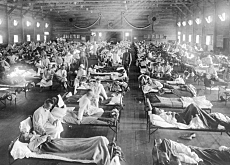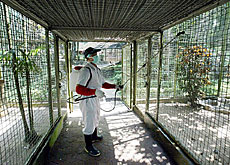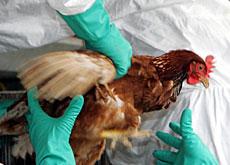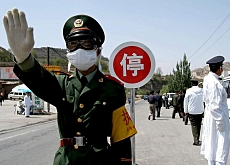Bird-flu relative rises from the ashes

Virologist Werner Wunderli tells swissinfo that the reconstructed Spanish flu virus will point the way to defeating a possible bird flu pandemic.
Two American research groups announced this week that they had been able to reconstitute from tissue samples the virus that killed millions worldwide in 1918.
Wunderli, who is head of Switzerland’s national influenza centre, said the two teams’ groundbreaking work could prove vital in the near future.
Research on the Spanish flu virus is not just of academic interest – it shows that the lethal strain is related to recent bird flu outbreaks.
The announcement comes as health specialists, worried that avian flu could cross over directly to humans, prepare for a potential pandemic.
swissinfo: What is the significance of these findings?
Werner Wunderli: It was not so clear why this virus was so deadly. The reconstruction of the virus, which was a considerable task, will allow scientists to understand how it functions.
The reconstructed virus shows some similarities with today’s avian flu virus, even if they are not identical. They share characteristics that need to be studied further.
swissinfo: Does this mean that if the fears of an avian flu pandemic are confirmed, there will be as many deaths?
W.W.: If the avian flu virus adapts itself to humans, it will be dangerous because there is no immunity in the population. The Spanish flu research shows that the 1918 virus seems to have appeared in birds before crossing directly over to humans, without using an intermediate host like pigs.
If bird flu adapts itself to humans, we will have a comparable situation. If it is a new virus, we can also expect major consequences because the population has considerably increased since the end of the First World War, as has mobility, and this favours transmission of a disease.
On the other hand we have medications, and we might have vaccines if we can produce them in time. So it’s a race against time if the avian flu virus adapts.
swissinfo: Was it safe to reconstruct a virus that killed millions of people?
W.W.: The people involved were perfectly aware of the security risks involved and took all the necessary precautions.
To carry out a research project of this type, the security prescriptions and laws are very stringent. So there is no way the virus could escape if these guidelines are followed. The virus can also be destroyed quite easily since it is not very resistant outside its host environment.
Of course if the virus fell into the wrong hands, there could be some danger. But it would require a lot of manpower to use it for the wrong purposes and even to replicate the results of the Spanish flu research.
swissinfo: So you don’t think these articles could be a blueprint for terrorists?
W.W.: I think the smallpox virus is much more dangerous than Spanish flu data. It is available as a complete virus, unlike Spanish flu, which needs to be reconstructed.
Of course if you have the money and the means, it’s like the atomic bomb: it can always fall into the wrong hands.
swissinfo: What about scientists who want virus samples? There is the risk that viruses will get out…
W.W.: The dissemination of viruses is strictly controlled. I need authorisations before I can get anything. And if I want to obtain samples, for example, of the smallpox virus from the United States, I can forget about it.
Exchanges of viruses are tightly controlled and you can’t just pass them on to anybody. Regulations make it impossible to even consider trading these samples.
Of course, if someone wants to break into a laboratory, it’s like a bank. There’s almost always a way of stealing something.
swissinfo-interview: Scott Capper
The 1918 Spanish flu pandemic killed up to 40 million people worldwide.
The First World War is believed to have killed up to nine million people.
In Switzerland, the flu caused 25,000 deaths and a quarter of the population was infected.
Many of the Swiss deaths were among young soldiers who had been mobilised during the war and spent much of their time in close contact with each other.
Two American research teams announced this week they had reconstructed and tested the 1918 Spanish flu virus.
One group, from the US Armed Forces Institute of Pathology, published in the latest edition of the science journal Nature the gene sequence of the virus, extracted from tissue samples.
The other team, based at the Center for Disease Control, (and whose results appear in Science) reconstructed the virus using the genome and tested it.

In compliance with the JTI standards
More: SWI swissinfo.ch certified by the Journalism Trust Initiative



You can find an overview of ongoing debates with our journalists here. Please join us!
If you want to start a conversation about a topic raised in this article or want to report factual errors, email us at english@swissinfo.ch.